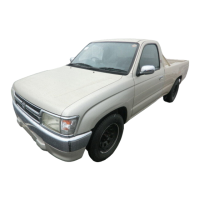300
4-3. Operating the lights and wipers
• When vehicles ahead appear from the
faraway lane on wide road
• When vehicles ahead have no lights
● The high beam may be turned off if a
vehicle ahead that is using fog lights
without using the headlights is
detected.
● House lights, street lights, traffic sig-
nals, and illuminated billboards or
signs may cause the high beam to
switch to the low beams, or the low
beams to remain on.
● The following factors may affect the
amount of time taken to turn the high
beam on or off:
• The brightness of headlights, fog
lights, and tail lights of vehicles ahead
• The movement and direction of vehi-
cles ahead
• When a vehicle ahead only has oper-
ational lights on one side
• When a vehicle ahead is a two-
wheeled vehicle
• The condition of the road (gradient,
curve, condition of the road surface
etc.)
• The number of passengers and
amount of luggage
● The high beam may be turned on or
off when the driver does not expect it.
● Bicycles or similar objects may not be
detected.
● In the situations shown below, the
system may not be able to accurately
detect surrounding brightness levels.
This may cause the low beams to
remain on or the high beams to cause
problems for pedestrians, vehicles
ahead or other parties. In these
cases, manually switch between the
high and low beams.
• In bad weather (rain, snow, fog, sand-
storms, etc.)
• The windshield is obscured by fog,
mist, ice, dirt, etc.
• The windshield is cracked or dam-
aged
• The camera sensor is deformed or
dirty
• When the temperature of the camera
sensor is extremely high
• Surrounding brightness levels are
equal to those of headlights, tail lights
or fog lights
• When headlights or tail lights of vehi-
cles ahead are turned off, dirty, chang-
ing color, or not aimed properly.
• When the vehicle is hit by water,
snow, dust, etc. from a preceding
vehicle
• When driving through an area of inter-
mittently changing brightness and
darkness
• When frequently and repeatedly driv-
ing ascending/descending roads, or
roads with rough, bumpy or uneven
surfaces (such as stone-paved roads,
gravel roads, etc.)
• When frequently and repeatedly tak-
ing curves or driving on a winding
road
• There is a highly reflective object
ahead of the vehicle, such as a sign or
mirror
• The back of a vehicle ahead is highly
reflective, such as a container on a
truck
• The vehicle’s headlights are damaged
or dirty
• The vehicle is listing or titling due to a
flat tire, a trailer being towed, etc.
• The high beam and low beam are
repeatedly being switched between in
an abnormal manner
• The driver believes that the high beam
may be causing problems or distress
to other drivers or pedestrians nearby
■ Switching to the low beam
Pull the lever to original position.
The Automatic High Beam indicator will
turn off.
Push the lever away from you to acti-
vate the Automatic High Beam system
again.
Turning the high beam
on/off manually

